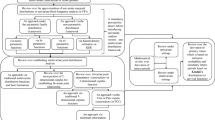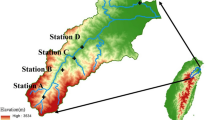Abstract
Applying copula-based bivariate flood frequency analysis is advantageous because the results provide information on both the flood peak and volume. More data are, however, required for such an analysis, and it is often the case that only data series with a limited record length are available. To overcome this issue of limited record length, data regarding climatic and geomorphological properties can be used to complement statistical methods. In this paper, we present a study of 27 catchments located throughout Norway, in which we assess whether catchment properties, flood generation processes and flood regime have an effect on the correlation between flood peak and volume and, in turn, on the selection of copulas. To achieve this, the annual maximum flood events were first classified into events generated primarily by rainfall, snowmelt or a combination of these. The catchments were then classified into flood regime, depending on the predominant flood generation process producing the annual maximum flood events. A contingency table and Fisher’s exact test were used to determine the factors that affect the selection of copulas in the study area. The results show that the two-parameter copulas BB1 and BB7 are more commonly selected in catchments with high steepness, high mean annual runoff and rainfall flood regime. These findings suggest that in these types of catchments, the dependence structure between flood peak and volume is more complex and cannot be modeled effectively using a one-parameter copula. The results illustrate that by relating copula types to flood regime and catchment properties, additional information can be supplied for selecting copulas in catchments with limited data.












Similar content being viewed by others
References
Agresti A (2013) Categorical data analysis, 2nd edn. Wiley, New York, pp 90–96
Aksoy H, Wittenberg H (2011) Nonlinear baseflow recession analysis in watersheds with intermittent streamflow. Hydrol Sci J 56(2):226–237. https://doi.org/10.1080/02626667.2011.553614
Arciniega A, Breña-Naranjo J, Pedrozo-Acuña A, Appendini C (2016) HYDRORECESSION: a Matlab toolbox for streamflow recession analysis. Comput Geosci 98(87):92. https://doi.org/10.1016/j.cageo.2016.10.005
Ben Aissia MA, Chebana F, Ouarda T, Bruneau P, Barbet M (2015) Bivariate index-flood model: case study in Québec, Canada. Hydrol Sci J 60:247–268. https://doi.org/10.1080/02626667.2013.875177
Brunner M, Viviroli D, Sikorska A, Vannier A, Favre A-C, Seibert J (2017) Flood type specific construction of synthetic design hydrographs. Water Resour Res 53:1390–1406. https://doi.org/10.1002/2016wr019535
Callau Poduje AC, Belli A, Haberlandt U (2014) Dam risk assessment based on univariate versus bivariate statistical approaches: a case study for Argentina. Hydrol Sci J 59(12):2216–2232. https://doi.org/10.1080/02626667.2013.871014
Chebana F, Ouarda T (2009) Index flood-based multivariate regional frequency analysis. Water Resour Res. https://doi.org/10.1029/2008wr007490
Fischer S, Schumann A, Schulte M (2016) Characterisation of seasonal flood types according to timescales in mixed probability distributions. J Hydrol 539:38–56
Fleig A (2013) Norwegian hydrological reference dataset for climate change studies. Technical Report 02. Norwegian water resources and energy directorate. Retrieved from http://webby.nve.no/publikasjoner/rapport/2013/rapport201302.pdf
Gaál L, Szolgay J, Kohnová S, Hlavčová K, Parajka J, Viglione A, Merz R, Blöschl G (2015) Dependence between flood peaks and volumes: a case study on climate and hydrological controls. Hydrol Sci J 60(6):968–984. https://doi.org/10.1080/02626667.2014.951361
Genest C, Favre A (2007) Everything you always wanted to know about copula modeling but were afraid to ask. J Hydrol Eng 12(4):347–368. https://doi.org/10.1061/(asce)1084-0699(2007)12:4(347)
Genest C, Rémillard B, Beaudoin D (2009) Goodness-of-fit tests for copulas: a review and a power study. Insur Math Econ 44(2):199–213. https://doi.org/10.1016/j.insmatheco.2007.10.005
Gottschalk L, Jensen Jørgen L, Lundquist D, Solantie R, Tollan A (1979) Hydrologic regions in the Nordic countries. Nord Hydrol 10:273–286
Grimaldi S, Serinaldi F (2006) Asymmetric copula in multivariate flood frequency analysis. Adv Water Resour 29(8):1155–1167. https://doi.org/10.1016/j.advwatres.2005.09.005
Grimaldi S, Petroselli G, Salvadori C, De Michele (2016) Catchment compatibility via copulas: A non-parametric study of the dependence structures of hydrological responses. Adv Water Resour 90:116–133
Hirschboeck K, Ely L, Maddox R (2000) Hydroclimatology of meteorologic floods. In: Wohl E (ed) Inland flood hazards: human, riparian and aquatic communities. Cambridge University Press, New York, pp 39–72. https://doi.org/10.5194/nhess-14-295-2014
Kojadinovic I, Yan J (2010) Modeling multivariate distributions with continuous margins using the copula R package. J Stat Softw 34(9):1–20
Mohr M (2008) New routines for gridding of temperature and precipitation observations for “seNorge.no”. Note no. 08/2008. Met.no, Oslo
Poulin A, Huard D, Favre A, Pugin S (2007) Importance of tail dependence in bivariate frequency analysis. J Hydrol Eng 12(4):394–403. https://doi.org/10.1061/(asce)1084-0699(2007)12:4(394)
Rémillard B, Scaillet O (2009) Testing for equality between two copulas. J Multivariate Analysis 100(3):377–386
Requena AI, Mediero L, Garrote L (2013) A bivariate return period based on copulas for hydrologic dam design: accounting for reservoir routing in risk estimation. Hydrol Earth Syst Sci 17:3023–3038. https://doi.org/10.5194/hess-17-3023-2013
Requena AI, Chebana F, Mediero L (2016) A complete procedure for multivariate index-flood model application. J Hydrol 535:559–580. https://doi.org/10.1016/j.jhydrol.2016.02.004
Saloranta T (2014) New version (v.1.1.1) of the seNorge snow model and snow maps for Norway. Report no. 6 – 2014. NVE, Oslo
Salvadori G, De Michele C (2004) Frequency analysis via copulas: theoretical aspects and applications to hydrological events. Water Resour Res 40(12):WR003133. https://doi.org/10.1029/2004wr003133
Salvadori G, De Michele C, Kottegoda N, Rosso R (2007) Extremes in nature: an approach using copulas. Springer, Dordrecht
Sraj M, Bezak N, Brilly M (2015) Bivariate flood frequency analysis using the copula function: a case study of the Litija station on the Sava River. Hydrol Process 29(2):225–238. https://doi.org/10.1002/hyp.10145
Szolgay J, Gaál L, Kohnová S, Hlavčová K, Výleta R, Bacigál T, Blöschl G (2015) A process-based analysis of the suitability of copula types for peak–volume flood relationships. Proc IAHS 370:183–188. https://doi.org/10.5194/piahs-370-183-2015
Tong X, Wang D, Singh V, Wu J, Chen X, Chen Y (2015) Impact of data length on the uncertainty of hydrological Copula modeling. J Hydrol Eng 20(4):05014019. https://doi.org/10.1061/(asce)he.1943-5584.0001039
Vandenberghe S, Verhoest N, De Baets B (2010) Fitting bivariate copulas to the dependence structure between storm characteristics: a detailed analysis based on 105 years 10 min rainfall. Water Resour Res 46:W01512. https://doi.org/10.1029/2009wr007857
Vormoor K, Lawrence D, Heistermann M, Bronstert A (2014) Climate change impacts on the seasonality and generation processes of floods in catchments with mixed snowmelt/rainfall regimes: projections and uncertainties. Hydrol Earth Syst Sci 19(6):6273–6309. https://doi.org/10.5194/hess-19-913-2015
Vormoor K, Lawrence D, Schlichting L, Wilson D, Wong W (2016) Evidence for changes in the magnitude and frequency of observed rainfall vs. snowmelt driven floods in Norway. J Hydrol 538:33–48. https://doi.org/10.1016/j.jhydrol.2016.03.066
Yue S, Rasmussen P (2002) Bivariate frequency analysis: discussion of some useful concepts in hydrological application. Hydrol Process 16(14):2881–2898. https://doi.org/10.1002/hyp.1185
Acknowledgements
The authors acknowledge the help of Wai Kwok Wong for extracting seNorge for the study catchments and Lena Schlichting for classifying their flood regimes.
Author information
Authors and Affiliations
Corresponding author
Ethics declarations
Conflict of interest
On behalf of all authors, the corresponding author states that there is no conflict of interest.
Rights and permissions
About this article
Cite this article
Filipova, V., Lawrence, D. & Klempe, H. Effect of catchment properties and flood generation regime on copula selection for bivariate flood frequency analysis. Acta Geophys. 66, 791–806 (2018). https://doi.org/10.1007/s11600-018-0113-6
Received:
Accepted:
Published:
Issue Date:
DOI: https://doi.org/10.1007/s11600-018-0113-6




